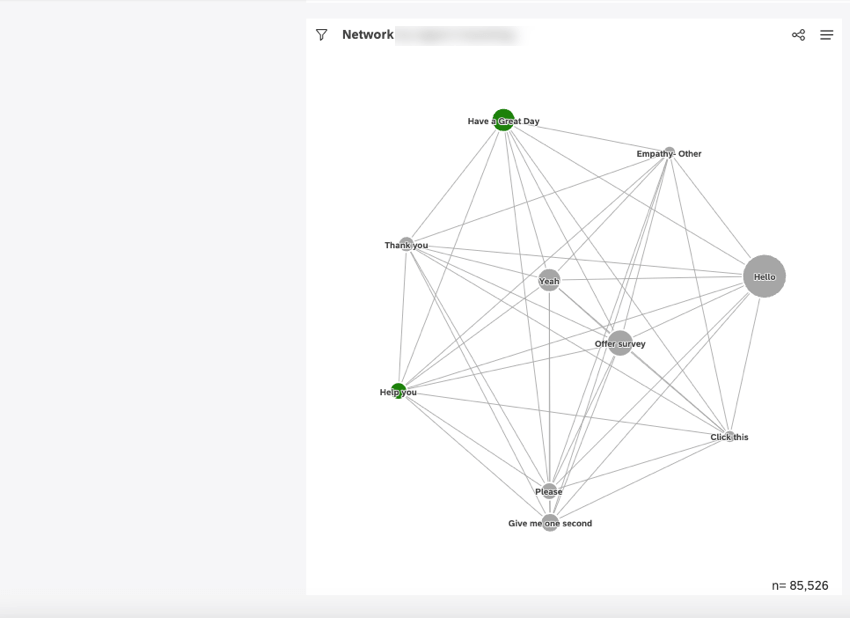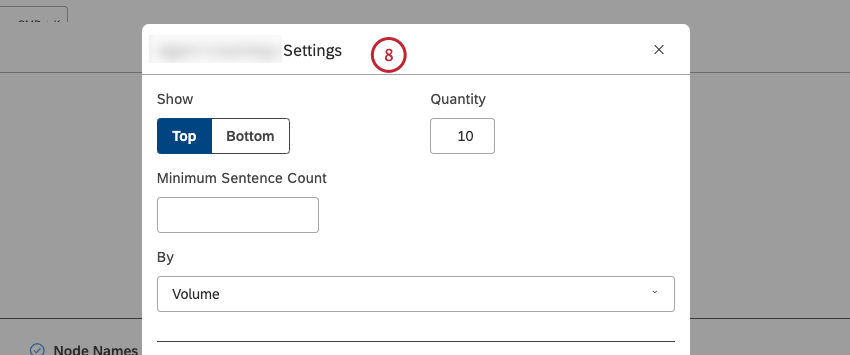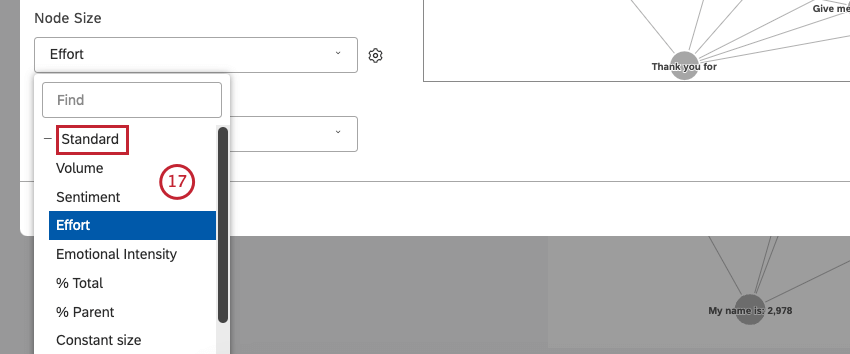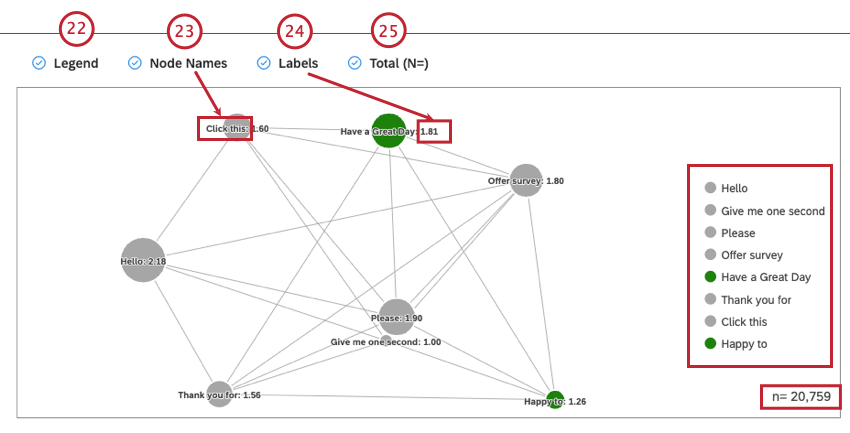Network Widget (Studio)
About the Network Widget
You can use the network widget to display data as an explorable web of connections. In a network widget, data groupings are displayed as nodes. Nodes that have a qualifying number of co-occurrences are connected with lines. Proximity between nodes is based on raw volume, meaning that large-volume topics usually have tighter clusters around them due to there being more co-occurrences.

For information about editing widget properties and more, see Widgets (XM Discover).
Adding a Network Widget
Properties Tab
You can edit widget properties in the Properties tab. For information about adding a widget, please see Adding a Widget.
Visualization Tab
You can define report settings in the Visualization tab.
- Select the Visualization tab.

- To enter your own widget title, click Custom title.
- Enter a custom report title into the box.

- Alternatively, click Auto Title to keep the automatically generated report title.
- Select the date range for the report. For all available options, see Date Range Filters.
 Qtip: Unless you set your widget to ignore the dashboard date range, the dashboard date range completely replaces the date range defined here.
Qtip: Unless you set your widget to ignore the dashboard date range, the dashboard date range completely replaces the date range defined here. - Select 1 of the following options by which to group data into a network of nodes:
- Topics
- NLP
- Attributes
- Derived AttributesFor an overview of available data groupings, see Grouping Data.
 Qtip: Click the plus ( + ) icon to view more options.
Qtip: Click the plus ( + ) icon to view more options.
- After you select a grouping option, click the gear icon next to it.

- Configure the subset of data that should be included in that grouping for the report in the Settings For an overview of available grouping settings, see Grouping Settings.
 Qtip: Grouping options that are not likely to be useful are grayed out. A grouping is grayed out when it is either empty or contains only a single value under the current filters (both widget-level and dashboard-level). This should help you focus your reports on the more meaningful data groupings without having to apply the trial and error method. You can select grayed out groupings if you need to.
Qtip: Grouping options that are not likely to be useful are grayed out. A grouping is grayed out when it is either empty or contains only a single value under the current filters (both widget-level and dashboard-level). This should help you focus your reports on the more meaningful data groupings without having to apply the trial and error method. You can select grayed out groupings if you need to. - Click Update.

- If you group data by topics in the Nodes menu, you can select Sentence to draw a line between topics if they occur within the same sentence.
 Qtip: Alternatively, select Interaction to draw a line between topics if they occur within the same interaction (for example, within the same chat, call, or individual feedback).Qtip: If you select Interaction, any other widgets that may potentially filter this widget with sentence-level criteria will be unlinked. Since interaction co-occurrence is based on an entire document, it loses references to sentence-level data such as sentiment, effort, and other NLP enrichments.
Qtip: Alternatively, select Interaction to draw a line between topics if they occur within the same interaction (for example, within the same chat, call, or individual feedback).Qtip: If you select Interaction, any other widgets that may potentially filter this widget with sentence-level criteria will be unlinked. Since interaction co-occurrence is based on an entire document, it loses references to sentence-level data such as sentiment, effort, and other NLP enrichments. - Select Volume (or Count) Greater than or Equal to to specify the minimum number of documents where the 2 nodes must occur together to show a connection between them.

- Enter the minimum number of documents where the 2 nodes must occur together to show a connection between them in the box below the menu.
Qtip: The bigger this number is, the less lines will appear in the widget, but the lines that do appear are likely to be more significant.
- Alternatively, you can select % Total Greater Than or Equal to to specify the minimum percentage of total for documents where the 2 nodes must occur together to show a connection between them.

- Enter the minimum percentage of total for documents where the 2 nodes must occur together to show a connection between them in the box below the menu.
Qtip: The bigger this number is, the less lines will appear in the widget, but the lines that do are likely to be more significant.Qtip: We recommend increasing the Only Show Connections with parameter when using interaction-based co-occurrences between topics to account for the wider net of discovery.
- Select the Show Animation checkbox to enable node animation.
 Qtip: Deselect this checkbox to disable node animation.
Qtip: Deselect this checkbox to disable node animation. - Select 1 of the following calculations to be reflected by the size of the network nodes:
- Standard: See step 17 for information about sorting options.
- Metrics: Node size reflects the value of a top box, bottom box, satisfaction, filtered, or custom math metric.
- Attributes: Node size reflects the calculated value of a selected attribute.
- Scorecards: Node size reflects the percentage of documents that pass or fail a selected rubric’s criteria.
 Qtip: Click the plus ( + ) icon to view more options.
Qtip: Click the plus ( + ) icon to view more options.
- You can sort the Standard metric by 1 of the following options:
- Volume (default): Node size reflects the number of related documents.
- Sentiment: Node size reflects the average sentiment of sentences from related documents.
- Effort: Node size reflects the average Effort score of sentences from related documents.
- Emotional Intensity: Node size reflects the average strength of emotions expressed in related documents.
- % Total: Node size reflects the grouping’s volume contribution to the widget’s total volume.
- % Parent: Node size reflects the grouping’s volume contribution to its parent grouping’s volume.
- Constant size: Make all nodes the same size.

- If you select the Constant size option, you can also change the overall node size (optional). Click the gear icon next to it.

- Select a number from 10 (largest size) to 1 (smallest size).
 Qtip: The default size is 2.
Qtip: The default size is 2. - Click Update.
- Select the color palette for the chart.
 Qtip: By default, nodes are colored according to their average sentiment using 5 sentiment bands.
Qtip: By default, nodes are colored according to their average sentiment using 5 sentiment bands. - Select the Labels checkbox to show numeric labels next to report items.
 Qtip: Deselect the Labels checkbox to hide numeric labels next to report items.
Qtip: Deselect the Labels checkbox to hide numeric labels next to report items. - Select this checkbox to show node names.
Qtip: Deselect this checkbox to hide node names.
- Select the Legend checkbox to show a chart legend. Deselect the Legend checkbox to hide a chart legend.
Qtip: Viewers can hide and show specific report items by clicking them in a legend.
- Select the Total (N=) checkbox to show the total number of documents that match report conditions and filters.
For more information on document volume, see Displaying Total Volume on Widgets (Studio).Qtip: Deselect this checkbox to hide the total number of documents that match report conditions and filters.Qtip: To set the default dashboard-wide value for new widgets, use the n= setting in dashboard properties.
Filters Tab
In the Filters tab, you can further narrow down report data. For information on widget filters properties, please see Applying Filters to a Widget.
